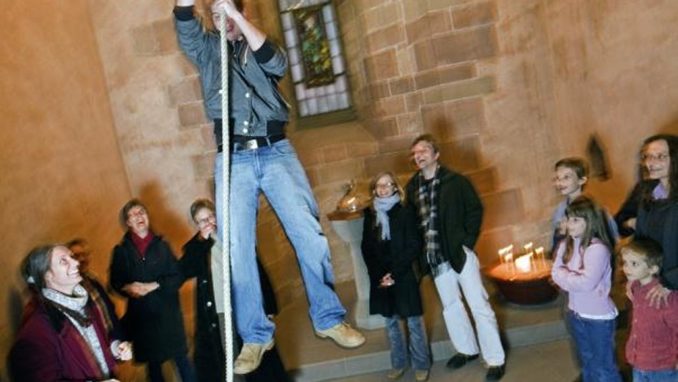
CIDSE – together for global justice – Licence CC BY-ND 2.0
Bells have been rung since time immemorial, but full circle bell ringing only began a few hundred years ago in this country. Bells on the continent are rung in various ways either mechanical or manual. Without full circle ringing, i.e. where the bell turns through 360°, the timing of the strike cannot be changed much as it is dictated by the physics of the bell and given that they weigh anything up to 80 cwt or 4 tons (Liverpool Cathedral Tenor Bell), that is a lot of physics.
Control is only achievable when the bell is at or near equilibrium: in other words, it is upside-down and just short of going all the way over (bad and potentially expensive and limb-threatening, see below). In this state, the bell can be accelerated by pulling earlier on the Sally or the tail, or slowed down by holding the bell at the balance for a little longer. Given the weight and momentum of even the lightest bells, unless they are at or near the balance point, there is no hope whatsoever of controlling them.
There is only one other place in the world where full circle bell ringing developed and that is in the Veneto region of Italy. Although there are differences in the design and way the bells are rung, English ringers can ring Venetian bells with a little training and vice-versa. Everywhere else (apart from the former colonies which use the English system), the bells are chimed manually or mechanically/electrically. The latter systems are known as Carillons or large cuckoo clocks.
Clearly, the English system is the best and it is a damned good way to get some exercise, have a laugh, meet people, go to competitions, visit other towers, discover hitherto unknown pubs and keep an aboriginal tradition going. Many ringers are not in the least bit religious, myself included, and do it to keep the tradition alive and go to the pub afterwards.
If you survive the initial phases of learning how to control the bell, raise it (by progressively putting more energy into the bell until it swings full circle and is said to be ‘up’) and lower it (by progressively reigning the bell in until it is at rest and is said to be ‘down’), you then get to the maths.
There are two types of ringing: Devon Call Changes and Method. Each group thinks their type of ringing is the best.
In Devon Call Changes, the ringing sequence is called by the conductor who usually rings the treble (No. 1 and the lightest of the bells). One of the shorter call changes is to the put the bells into Queen’s (135246) on six bells (13572468 on eight and so on) and then hunt each bell out to the back. The sequence on 6 bells is as follows:
123456 (rounds – you always start in rounds) -> 1st Call: 4 to 5.
This means 4 follows 5 which means 5 now follows the bell 4 was following before the change was called, i.e. the 3. The first bell in a call holds off while the second bell cuts in front to effect the change: so in this call, the 4 holds off while the 5 cuts in front, thus taking the fourth’s place following the third. Because the tenor (No. 6 in a six-bell tower and the heaviest of the bells) always stays at the back, it now follows the 4 instead of the 5 as the sequence is 123546, and so on and so forth.
It is important to know which bell the bell you are following is following, otherwise you will get lost, chaos will ensue, and you will muck it up for the others and frighten all the sheep within a couple of miles of the tower. One other thing to remember which makes things simpler, is that bell positions can only move by one place at a time: in rounds (123456), as 5 is following 4, they can swap positions, but 5 and 2 cannot, as their relative positions mean that the bells are too far apart in their ringing cycle to perform the change without causing havoc. So to get back to our call changing:
123456 (rounds)-> 1st Call: 4 to 5 -> 123546 -> 2nd Call: 2 to 3 -> 132546 -> 3rd Call: 2 to 5 -> 135246 (Queen’s)
Next, take the treble to the back:
1 to 3 (3 is now leading off the tenor – i.e. on the opposite stroke to it) -> 315246 -> 1 to 5-> 351246 -> 1 to 2, -> 352146 -> 1 to 4 -> 352416. The treble is now at the back as it is being followed by the tenor.
Next, take the 3 to the back:
352416 -> 3 to 5 (5 lead), 3 to 2, 3 to 4, 3 to 1-> 524136
Now the 5:
5 to 2 (2 lead), 5 to 4, 5 to 1, 5 to 3 – 241356.
Then the two remaining change bells (2 and 4) are taken to the back in the same way which gets you back into Queen’s (135246).
Now all that remains is to get the bells back into rounds. The sequence is:
5 to 2 -> 132546; 3 to 2 -> 123546; 5 to 4 -> 123456 (rounds).
Methods do not have a conductor. You learn a pattern and the changes occur on every stroke (Sally and tail) as opposed to only the Sally stroke in Devon Call Changes. Peals have interesting names like Grandsire, Canterbury Surprise Major and Little Bob Minor. A full peal is around 5040 changes and takes several hours. Method ringing is much more prevalent than Devon Call Changes which, as you might have guessed, is confined to Devon. Method ringers learn call changes before they move on to learning methods, but not to the same degree of precision as in Devon.
In its cycle, the bell goes upside-down twice as you would expect. Once on the hand stroke (or Sally stroke) and once on the backstroke (or tail). The Sally is the fluffy bit at head height when the bell is either resting against the stay or is ‘down’. The stay is a length of ash attached to the headstock which prevents the bell from going over the top and is used to ‘stand’ the bells upside-down so that they can subsequently be rung without having to raise and lower them every time you want to ring (like they have to in Italy).
Stays are designed to break if they are clobbered too hard (usually by learners pulling too hard), in order to protect the bell bearings and frame and stop the bell from crashing through the floor and killing everyone it encounters on its path of destruction. If the stay breaks and the bell does go over, the rope, which is attached to a large wheel connected to the bell, disappears through the 4-inch hole in the ceiling at very high speed and generally thrashes about on its way. At this point it is a good idea to let go of the rope and run away.
Like a great number of other traditions, bell ringing is dying. There are very few young people coming into ringing and the older ones with vast experience are getting older and dying and are not being replaced. Many villages and towns across the country no longer have teams. Some towers only get rung by visiting teams while others don’t get rung at all. Like anything mechanical, if the bells are not rung and looked after, they become less and less ringable and eventually, another tower becomes unringable and unless large sums of money are raised (starting at about £50k), it remains silent forever.
To get around the NIMBY problem encountered in towns whose inhabitants hate the sound of the bells for whatever petty reason, the bells can be silenced by tethering their clappers and connecting the bell wheels via photoelectric cells to a computer in the ringing chamber running software that simulates the sound of the bells at the correct moment so that the ringers can hear what they are doing. The NIMBYs can be silenced by tethering their bell-ends to the clappers.
There is nothing so quintessentially English as the sound of church bells ringing out and it’s good for staving off dementia, it’s cheaper than the gym and it keeps something incredibly valuable alive. It is that sense of belonging, woven into the fabric of all things British (or French in France, Italian in Italy, etc.), including bell ringing, that the traitorous fuckers in Westminster, Brussels, the UN and elsewhere are desperate to destroy and that my parents fought the Nazis to preserve. So do your bit, get bell ringing and stick two fingers up to Johnny Roper, Johnny NWO and Johnny SJW.
© PastMySellByDate 2016



